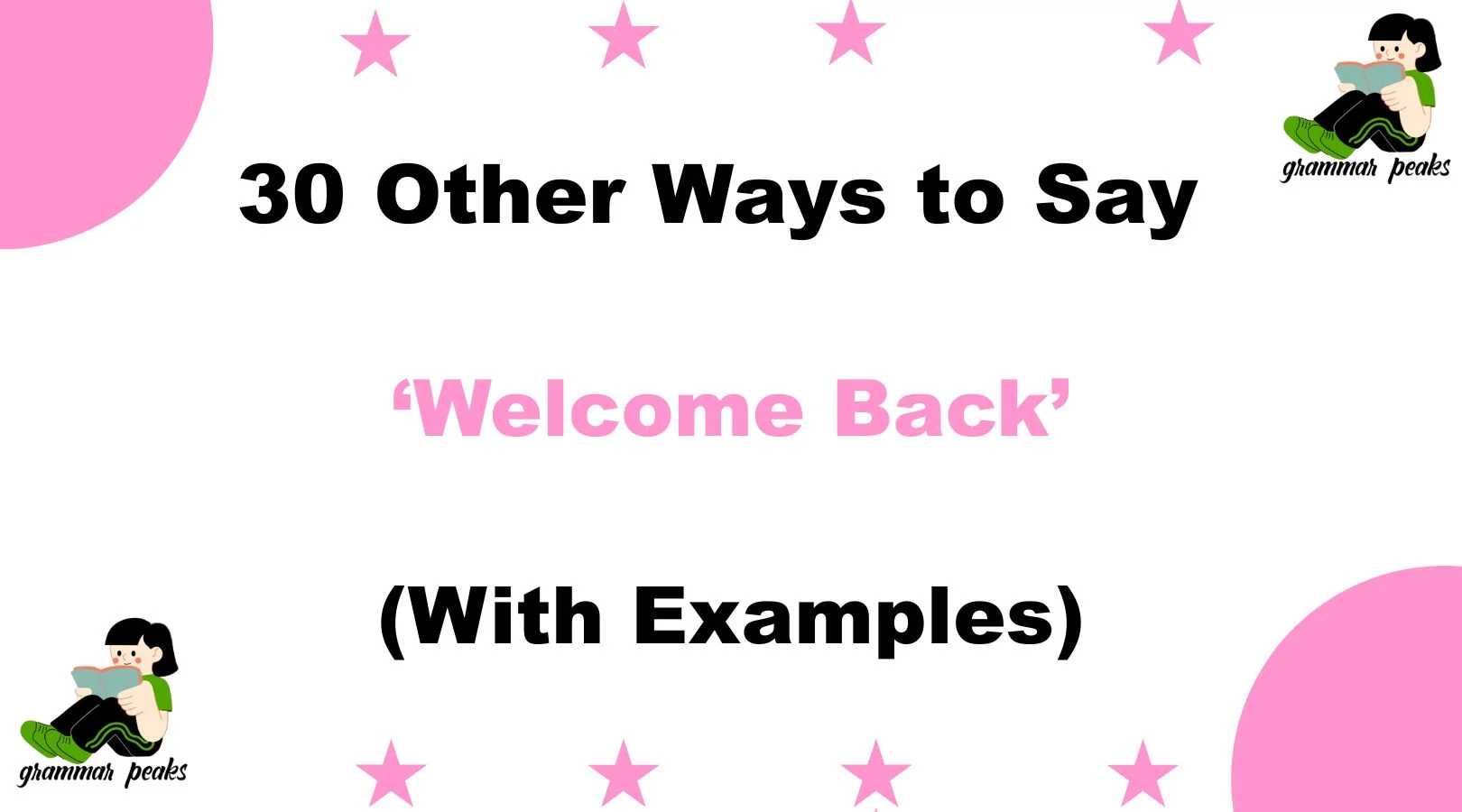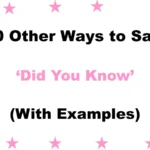Finding the right words to express care and warmth can make a big difference in how someone feels when they return. Saying “Welcome back” is simple, but sometimes, we want to make our greetings more personal, meaningful, or suited to the moment.
Whether it’s welcoming a friend, colleague, or family member, having a variety of heartfelt alternatives lets you connect on a deeper level. In this article, you’ll discover 30 thoughtful ways to say “Welcome back”, complete with definitions, examples, and guidance on when and how to use each phrase with the perfect tone.
What Does “Welcome Back” Mean?
“Welcome back” is a friendly phrase used to greet someone who has returned after being away for some time. It conveys warmth, acknowledgement, and appreciation for the person’s return. This phrase helps reaffirm connection and can make the returning individual feel valued and noticed.
When to Use “Welcome Back”
You use “Welcome back” when someone comes back to a place or situation—like returning home, rejoining work, or coming back from a trip or break. It’s most fitting in informal to semi-formal settings where you want to show kindness and recognition.
Is It Professional/Polite to Say “Welcome Back”?
Yes, “Welcome back” is generally professional and polite. It works well in workplaces, schools, and social settings. However, depending on the context, you might want to choose alternatives that better fit formal or casual tones.
Pros and Cons of Saying “Welcome Back”
Pros:
- Simple and clear
- Warm and friendly
- Easily understood by all
Cons:
- Can feel generic or repetitive
- May lack personal touch in some situations
- Might not convey enough enthusiasm or care for special occasions
Synonyms for “Welcome Back”
- Great to see you again
- It’s wonderful to have you back
- Glad you’re here again
- Happy to see you return
- Nice to have you back with us
- So pleased you’re back
- Welcome home
- It’s good to have you back
- Long time no see!
- You’ve been missed
- Good to have you back
- We missed you around here
- Look who’s back!
- It’s a pleasure to see you again
- Welcome back to the team
- Glad you made it back
- It’s great to catch up again
- Back in action!
- Happy to have you back on board
- It’s awesome to see you again
- Welcome back, friend
- You’re back where you belong
- So happy you’re back
- We’re thrilled to have you back
- Welcome back, stranger!
- It’s fantastic to see you again
- You’re back, and we’re better for it
- Happy to have you return
- Welcome back to your favorite place
- Glad to see you’ve come back
1. Great to See You Again
Definition: A warm, friendly greeting showing happiness at someone’s return.
Explanation: This phrase expresses pleasure in seeing someone after some time apart.
Scenario Example: Greeting a coworker who has returned from vacation.
Best Use: Informal or semi-formal settings among friends or colleagues.
Worst Use: Formal business communication.
Tone: Warm, casual, friendly.
2. It’s Wonderful to Have You Back
Definition: A heartfelt phrase emphasizing joy at the person’s return.
Explanation: Shows genuine happiness and appreciation for the person’s presence again.
Scenario Example: Welcoming a family member after a long trip.
Best Use: Personal and semi-formal situations.
Worst Use: Situations needing brief, neutral greetings.
Tone: Warm, caring, sincere.
3. Glad You’re Here Again
Definition: A simple, warm way to express pleasure at someone’s return.
Explanation: Communicates happiness that the person is back without being overly formal.
Scenario Example: Greeting a teammate returning from an absence.
Best Use: Casual workplace or social settings.
Worst Use: Formal or highly professional events.
Tone: Friendly, approachable.
4. Happy to See You Return
Definition: Expresses positive feelings about the person’s comeback.
Explanation: Highlights the emotional satisfaction of having the person back.
Scenario Example: Greeting a friend after they move back to town.
Best Use: Social, informal, or heartfelt moments.
Worst Use: Brief or distant communication.
Tone: Warm, welcoming.
5. Nice to Have You Back with Us
Definition: A welcoming phrase emphasizing group inclusion.
Explanation: Shows that the person’s presence adds value to the group or team.
Scenario Example: Welcoming an employee back after leave.
Best Use: Professional and group settings.
Worst Use: Too casual for some formal workplaces.
Tone: Warm, inclusive, respectful.
6. So Pleased You’re Back
Definition: A polite, enthusiastic greeting.
Explanation: Expresses joy and satisfaction that the person has returned.
Scenario Example: Greeting a colleague after a business trip.
Best Use: Semi-formal or casual professional settings.
Worst Use: Very formal or distant scenarios.
Tone: Polite, warm.
7. Welcome Home
Definition: A heartfelt phrase used for someone returning to their residence or familiar place.
Explanation: Implies comfort and belonging.
Scenario Example: Greeting a family member after a long absence.
Best Use: Personal, familial settings.
Worst Use: Professional or public places.
Tone: Warm, loving, intimate.
8. It’s Good to Have You Back
Definition: A warm, friendly acknowledgment of someone’s return.
Explanation: Shows appreciation for the person being back.
Scenario Example: Greeting a team member after sick leave.
Best Use: Informal to semi-formal workplace settings.
Worst Use: Too casual for very formal communications.
Tone: Friendly, sincere.
9. Long Time No See!
Definition: A casual, playful way to acknowledge someone’s return after a long time.
Explanation: Indicates the person’s absence was noticeable.
Scenario Example: Greeting an old friend who returns after years.
Best Use: Informal social settings.
Worst Use: Professional or formal environments.
Tone: Casual, friendly, light-hearted.
10. You’ve Been Missed
Definition: An affectionate phrase expressing that someone’s absence was felt.
Explanation: Conveys emotional warmth and care.
Scenario Example: Welcoming a close friend back after a trip.
Best Use: Personal, intimate contexts.
Worst Use: Formal or distant relationships.
Tone: Warm, caring, affectionate.
11. Good to Have You Back
Definition: A friendly and familiar greeting acknowledging someone’s return.
Explanation: It reflects genuine appreciation for the person’s presence again.
Scenario Example: Saying this to a coworker who just returned after parental leave.
Best Use: Professional and casual environments alike.
Worst Use: Formal business or academic settings needing structured tone.
Tone: Warm, friendly, approachable.
12. We Missed You Around Here
Definition: A heartfelt phrase indicating the person’s absence was noticeable.
Explanation: Highlights emotional presence and value within a group.
Scenario Example: Telling a teammate this after they come back from sick leave.
Best Use: Informal workplace or friend circles.
Worst Use: Places where emotional expressions are discouraged.
Tone: Affectionate, warm, informal.
13. Look Who’s Back!
Definition: A playful and energetic way to acknowledge someone’s return.
Explanation: Light-hearted and informal, often used among friends.
Scenario Example: Greeting a college buddy after summer break.
Best Use: Fun, relaxed environments like home or casual office spaces.
Worst Use: Formal settings or with people you don’t know well.
Tone: Humorous, cheerful, casual.
14. It’s a Pleasure to See You Again
Definition: A polite and formal greeting showing respect and warmth.
Explanation: Suitable for professional or respectful settings where warmth is still appropriate.
Scenario Example: Welcoming a guest speaker returning for another session.
Best Use: Business or formal gatherings.
Worst Use: Casual friend groups where it might feel too stiff.
Tone: Respectful, courteous, formal.
15. Welcome Back to the Team
Definition: A professional phrase to greet a returning team member.
Explanation: Emphasizes their role and belonging in the group.
Scenario Example: Manager greeting an employee returning after a long leave.
Best Use: Corporate, project, or sports teams.
Worst Use: One-on-one or casual social circles.
Tone: Inclusive, team-focused, encouraging.
16. Glad You Made It Back
Definition: A friendly expression of relief or happiness at someone’s return.
Explanation: Often used when someone returns safely or after travel.
Scenario Example: Greeting a friend after an overseas trip.
Best Use: Social, travel-related, or mildly informal situations.
Worst Use: Formal settings where more structured language is expected.
Tone: Caring, relaxed, supportive.
17. It’s Great to Catch Up Again
Definition: A phrase that emphasizes reconnecting and resuming conversation.
Explanation: Useful when you plan to or are already engaging with the person again.
Scenario Example: Chatting with a returning colleague over coffee.
Best Use: Social or semi-professional gatherings.
Worst Use: First-time meetings or highly formal contexts.
Tone: Friendly, conversational, open.
18. Back in Action!
Definition: A lively, energetic phrase celebrating someone’s return to routine.
Explanation: Often used when someone is resuming their role or responsibilities.
Scenario Example: Greeting a coworker returning to their desk after recovery.
Best Use: Workplace, sports, or hobby groups.
Worst Use: Serious or solemn occasions.
Tone: Enthusiastic, fun, energetic.
19. Happy to Have You Back on Board
Definition: A professional yet warm phrase indicating return to a team or organization.
Explanation: Suitable for work-related contexts, especially in corporate settings.
Scenario Example: Welcoming an employee after maternity leave.
Best Use: Office, HR, or onboarding environments.
Worst Use: Casual settings where it may sound overly formal.
Tone: Respectful, positive, corporate.
20. It’s Awesome to See You Again
Definition: A casual and upbeat phrase for greeting someone enthusiastically.
Explanation: Adds energy and emotion to the greeting.
Scenario Example: Saying this to a childhood friend who returns for a reunion.
Best Use: Informal and lively contexts.
Worst Use: Professional meetings or events.
Tone: Joyful, enthusiastic, personal.
21. Welcome Back, Friend
Definition: A personal and affectionate greeting focused on the relationship.
Explanation: Uses direct address to strengthen emotional connection.
Scenario Example: Greeting a friend after a long move or life change.
Best Use: Personal and emotionally open relationships.
Worst Use: Formal or distant relationships.
Tone: Warm, heartfelt, friendly.
22. You’re Back Where You Belong
Definition: A meaningful phrase indicating someone’s return to a comforting or rightful place.
Explanation: Often used in emotional or dramatic contexts to express deep appreciation.
Scenario Example: Welcoming a loved one home after a long absence.
Best Use: Family, romantic, or emotional reunions.
Worst Use: Professional settings.
Tone: Deep, emotional, sentimental.
23. So Happy You’re Back
Definition: A genuine and clear expression of joy at someone’s return.
Explanation: Suitable for both spoken and written greetings.
Scenario Example: Texting a friend after they return from a trip.
Best Use: Casual, friendly interactions.
Worst Use: Formal documents or business communication.
Tone: Lighthearted, sincere, cheerful.
24. We’re Thrilled to Have You Back
Definition: A high-energy phrase that shows group excitement.
Explanation: Excellent for welcoming someone to a team, event, or organization.
Scenario Example: A company-wide email greeting a returning team member.
Best Use: Teams, events, or group reintroductions.
Worst Use: One-on-one interactions where it may feel exaggerated.
Tone: Upbeat, celebratory, enthusiastic.
25. Welcome Back, Stranger!
Definition: A playful phrase often used when someone’s been away a long time.
Explanation: Uses light sarcasm to point out someone’s absence humorously.
Scenario Example: Greeting an old friend who hasn’t visited in years.
Best Use: Friendships, close relationships.
Worst Use: Formal or sensitive situations.
Tone: Humorous, playful, informal.
26. It’s Fantastic to See You Again
Definition: A positive and enthusiastic greeting.
Explanation: Stronger than simply “great,” showing a higher level of excitement.
Scenario Example: Welcoming a guest speaker returning to your event.
Best Use: Professional and social occasions alike.
Worst Use: Settings requiring brief or neutral language.
Tone: Professional, excited, respectful.
27. You’re Back, and We’re Better for It
Definition: A powerful phrase showing that the person’s return has a positive impact.
Explanation: Emphasizes value and importance of the individual.
Scenario Example: Saying this to a beloved team leader.
Best Use: Appreciation-based work environments or personal messages.
Worst Use: Too strong for casual or superficial acquaintances.
Tone: Affirming, grateful, emotional.
28. Happy to Have You Return
Definition: A simple and sincere way to express gladness at someone’s comeback.
Explanation: Best for soft, friendly reintroductions.
Scenario Example: Messaging a neighbor who just got back from vacation.
Best Use: Friendly emails, text messages, casual greetings.
Worst Use: Corporate or public announcements.
Tone: Calm, genuine, kind.
29. Welcome Back to Your Favorite Place
Definition: A light and affectionate way of making someone feel comfortable again.
Explanation: Adds a fun twist by calling the place “their favorite.”
Scenario Example: Welcoming a friend to their regular coffee shop hangout.
Best Use: Cafés, clubs, homes, or places of habit.
Worst Use: When the “favorite place” is not sincere.
Tone: Playful, warm, familiar.
30. Glad to See You’ve Come Back
Definition: A friendly, neutral phrase showing pleasure at someone’s return.
Explanation: Can work well in both personal and professional scenarios.
Scenario Example: Saying this to a coworker returning to a project.
Best Use: Mixed or semi-professional environments.
Worst Use: Highly emotional reunions where a more heartfelt message is needed.
Tone: Friendly, calm, neutral.
Conclusion
In any relationship—professional or personal—the words we choose to welcome someone back can shape how they feel about returning. Whether you want to be enthusiastic, sincere, respectful, or even a little playful, there’s an alternative on this list that fits. By using these 30 unique phrases, you can ensure that your greeting is not only heard but felt, making the person feel valued, appreciated, and genuinely missed.
Warm, thoughtful communication isn’t about using fancy words—it’s about using the right ones. Now that you have these alternatives, you’re well-equipped to greet anyone with the warmth and care they deserve.
FAQs
1. What is the best alternative to saying “Welcome Back” in a professional email?
A great professional alternative is “Happy to have you back on board” or “It’s a pleasure to see you again.” These phrases maintain a respectful and polished tone while still expressing warmth and appreciation.
2. Can I use playful alternatives like “Look who’s back!” in the workplace?
Yes, but only in casual work environments or with close colleagues where a playful tone is appropriate. For formal or hierarchical workplaces, stick to more polite and professional phrases like “Good to have you back.”
3. How can I welcome someone back after a long absence due to illness or leave?
Be sensitive and sincere. Use phrases like “We missed you around here” or “So happy you’re back.” Avoid overly energetic or humorous phrases that may come off as insensitive or dismissive of their experience.
4. Are these alternatives appropriate for welcoming someone back online or virtually?
Absolutely! You can use phrases like “Great to catch up again” or “It’s awesome to see you again” in virtual meetings, group chats, or emails. Just be mindful of tone—adjust your choice depending on the formality of the setting.
5. Why should I avoid always saying “Welcome Back”?
While there’s nothing wrong with “Welcome Back,” using more personalised or varied phrases can help your message feel more heartfelt and thoughtful. It shows effort, attentiveness, and adds a human touch—especially important in relationships and professional interactions.






